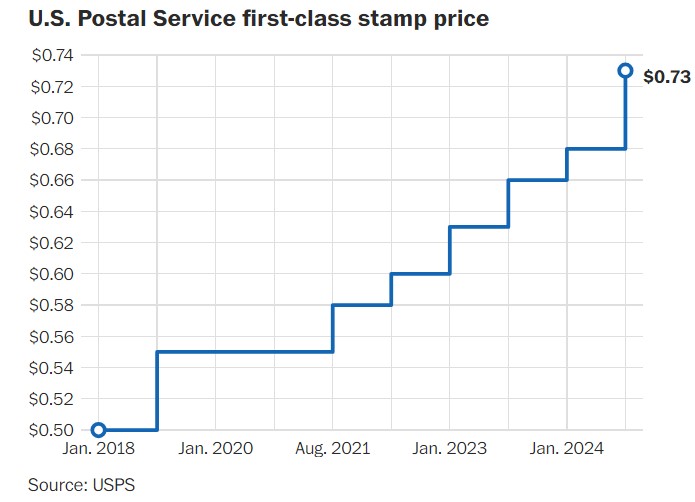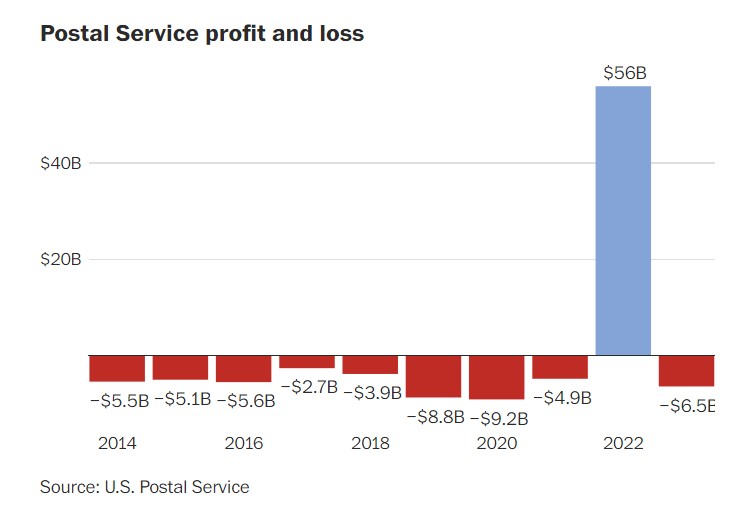Indeed, everything Postmaster DeJoy has done has slowed the USPS even more . . . USPS plans rural slowdown after election to cut costs, The Washington Post (archive.ph) Top U.S. Postal Service officials are considering plans to allow slower mail delivery in the coming months for long-distance and rural service to cut costs at the financially troubled agency — but not until after the election. The changes would give customers within 50 miles of the Postal Service’s largest processing facilities faster delivery service, which accounts for the vast majority of mail and packages, Postmaster General Louis DeJoy told The Washington Post. But the agency cannot afford to maintain the same model for deliveries into far-flung areas, he said. That
Topics:
Angry Bear considers the following as important: DeJoy, politics, Taxes/regulation, USPS
This could be interesting, too:
Robert Skidelsky writes Lord Skidelsky to ask His Majesty’s Government what is their policy with regard to the Ukraine war following the new policy of the government of the United States of America.
Joel Eissenberg writes No Invading Allies Act
Ken Melvin writes A Developed Taste
Bill Haskell writes The North American Automobile Industry Waits for Trump and the Gov. to Act
Indeed, everything Postmaster DeJoy has done has slowed the USPS even more . . .
USPS plans rural slowdown after election to cut costs, The Washington Post (archive.ph)
Top U.S. Postal Service officials are considering plans to allow slower mail delivery in the coming months for long-distance and rural service to cut costs at the financially troubled agency — but not until after the election.
The changes would give customers within 50 miles of the Postal Service’s largest processing facilities faster delivery service, which accounts for the vast majority of mail and packages, Postmaster General Louis DeJoy told The Washington Post. But the agency cannot afford to maintain the same model for deliveries into far-flung areas, he said. That could add an additional day to current delivery timetables.
“At the end of the day, I think some portion of the mail showing up 12 hours later, I think it’s a price that had to be paid for letting this place be neglected,” DeJoy said. “You look around every other country, [delivery] is longer, it’s much more expensive. We’re trying to save the Postal Service — not figuratively, not to advocate for something. We’re trying to literally save the Postal Service.”
DeJoy said the new policy would not be implemented until after November’s elections. The Postal Service filed plans Thursday with its regulator to hold public hearings to solicit feedback on the proposed changes.
Four years ago, similar cost-cutting moves prompted litigation over fears voting would be disrupted. Ultimately, the agency helped nearly half of all 2020 voters request or cast ballots by mail, according to the University of Florida’s U.S. Elections Project.
In the plans under discussion, the Postal Service would allow mail and packages to sit at certain facilities for an extra day instead of transporting them immediately for processing and delivery, DeJoy said. That would extend acceptable delivery times for mail traveling longer distances.
Pilots of the policy have been in place in certain areas, mostly rural, for months.
The new delivery standards require the approval of the agency’s nine-member governing board. They also must be reviewed by the Postal Regulatory Commission, though the panel’s recommendation is nonbinding.
The Postal Service is still reeling from the aftermath of mail slowdowns around the 2020 election. In a drive to cut costs and improve operations, DeJoy-led initiatives snarled mail processing nationwide, with changes that experts say jeopardized ballot access for tens of millions of Americans.
The Postal Service faced a bevy of lawsuits over the 2020 policies and ultimately took “extraordinary measures” that saw nearly 98 percent of ballots delivered from voters to election officials within three days. The agency has generally won praise for its handling of ballots in numerous elections since.
“The Postal Service, especially as it leads up to Election Day, really does go to extraordinary measures to try to make sure that every voter who’s mailed their ballot on time, that it gets delivered so it can be counted and that their voices are heard,” said Tammy Patrick, who leads the National Association of Election Officials. “But when we shift that ballot return or that mail volume into the final days, it presents more pressure on the Postal Service to deliver not only within their delivery standards, but [faster than] their delivery standards.
The Postal Service has faced difficulty in meeting those standards in recent months. The agency delivered 83.4 percent of first-class mail on time the week of Aug. 12, according to postal data firm SnailWorks. The agency’s target is 95 percent on time.
Across the country, though, the Postal Service is exceeding the 95 percent target when delivering items with a one-day grace period, according to the agency’s online data dashboard.
Allowing marginally slower service to rural areas, which often drag down on-time rates, could improve the agency’s delivery metrics, experts say.
DeJoy and the board of governors have already eased the Postal Service’s goals in recent years. Until 2021, the agency aimed to deliver all first-class mail in at most three days. DeJoy extended that in 2021 as part of his 10-year cost-cutting plan to up to five days. The agency has also raised the price of first-class postage by 33 percent in the past four years.
“Any effort to degrade service while raising prices is a recipe for a death spiral at the Postal Service,” Rep. Gerry Connolly (D-Va.), a leading DeJoy critic, said in a statement. “This is the second time Postmaster General DeJoy has proposed lower service standards. He might as well announce a return to delivering mail by horse and buggy.”
The GOP-controlled House Appropriations Committee also rebuked parts of DeJoy’s 10-year plan, writing that it was “deeply concerned about the potential negative impacts on mail service to the American people, customer satisfaction, and cost overruns.”
DeJoy in an interview shot back that lawmakers were “out of their league” with their critiques of the agency.
“They don’t understand the business. Nobody knows what it takes to compete with FedEx and UPS and drives billions of dollars of cost out of here that’s in the critique business. Even though it’s Congress, they don’t know.”
The price and delivery changes have done little to stabilize the Postal Service’s finances. The agency is on pace to lose more than $7 billion in the 2024 fiscal year, and it lost $6.5 billion in fiscal 2023. In 2022, Congress passed a $107 billion plan to stabilize the mail service’s balance sheet after worries during the pandemic that it could not survive another financial shock.
The agency’s “universal service obligation” — its requirement to serve rural areas with low-margin products even at a financial loss — has driven much of the financial struggles. Its private-sector competitors, such as FedEx, UPS and Amazon, often take advantage of that mandatory service to avoid delivering to unprofitable locations. (Amazon founder Jeff Bezos owns The Post.)
For parcels, the practice does make the Postal Service money, but it still saddles the agency with the least-lucrative routes while its competitors build out their distribution network in the most attractive areas. As postal delivery service slows, some stakeholders worry it could drive business away from the mail agency.


